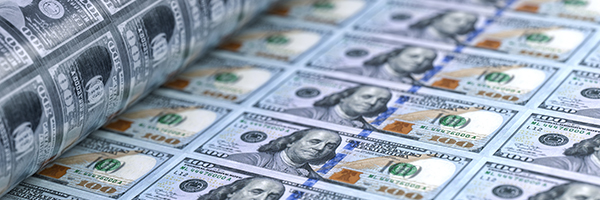
April 14, 2025 | Daily JAM |
Goldman Sachs has taken a look at how difficult it would be for U.S. companies to find alternatives to Chinese sources of supply in a global trade/tariff war. And the picture isn’t very pretty.

April 14, 2025 | Daily JAM |
When the House and Senate convene again on April 28, Republicans will test whether the extremely precarious deals they sort of hammered out before leaving town will hold up so that they can deliver President Donald Trump’s big beautiful spending bill (for the 2025 fiscal year that started in October 2024) with its $5.5 trillion or so in tax cuts, its money for border and immigration crackdowns, and an increase in the debt ceiling. How shaky are those deals? The Washington Post this morning put together a detailed list of examples that show how little actual agreement there is between the House and the Senate.

April 13, 2025 | Daily JAM |
Commerce Secretary Howard Lutnick said on Sunday the administration’s decision to exclude smartphones, computers and other popular electronic items from reciprocal tariffs was just temporary. The items will be subject to “semiconductor tariffs, expected to be implemented in “a month or two,” Lutnick said in an interview with ABC. “All those products are going to come under semiconductors, and they’re going to have a special focus type of tariff to make sure that those products get reshored.” President Donald Trump on Friday exempted a host of consumer electronic devices from reciprocal tariffs that include 125% tariffs on Chinese imports and 10% baseline tariffs on other countries. President Trump himself on Sunday posted that phones, computers and other popular electronic items will still be hit by tariffs.

April 12, 2025 | Daily JAM |
Late Friday, April 11, the Trump administration announced that smartphones, computers and other electronic components are exempt from reciprocal tariffs, days after the United States imposed the highest levies on foreign goods in a century.

April 11, 2025 | Daily JAM, Morning Briefing |
China retaliated against President Donald Trump’s latest tariffs by hiking duties on all U.S. goods. Beijing will raise tariffs on all U.S. goods to 125% from 84% starting April 12, the Ministry of Finance said on Friday, after the White House clarified that levies on Chinese goods rose to 145% this year. This will be the last increase in tariffs from China–which, it turns out, isn’t because China has decided to be kind. “Given that American goods are no longer marketable in China under the current tariff rates, if the United States further raises tariffs on Chinese exports, China will disregard such measures,” according to the statement from the Ministry of Finance. Tariffs are now at levels set to halt most all trade between the world’s biggest economies.

April 10, 2025 | Daily JAM |
It’s easy to get so caught up in the current increases and decreases of the Trump tariffs that we lose track of how big an increase even the reduced 10% global tariff that President Donald Trump announced on Wednesday, April 9, is from the pre-Trump rates. At the end of 2024, the average effective tariff rate for the United States was 2.2%, according to the World Trade Organization (WTO).

April 10, 2025 | Daily JAM, Morning Briefing |
CPIS inflation cooled in March. The all-items or headline inflation rate fell by 0.1% in March from February. That was the first monthly decrease in nearly five years. The core Consumer Price Index, which excludes more volatile food and energy prices, increased by just 0.1% from February, the least in nine months, according to Bureau of Labor Statistics data on Thursday.
The slowdown in the all-items rate reflected a drop in prices for energy, used vehicles, hotel stays and airfares. The cost of motor vehicle insurance — a main source of inflation in recent years — also retreated. But, and this is an important caveat, the numbers were too early capture much of the effect of higher tariffs.

April 10, 2025 | Daily JAM |
President Donald Trump has pledged tariffs on drugs exported to the United States. Besides the threat to supply chains that could disrupt the supply of drugs to U.S. consumers, the potential tariffs threaten a clash between drugmakers and insurers over who will pay the higher prices.

April 9, 2025 | Daily JAM |
We started off the day with the stock and bond markets headed for another retreat on news that the European Union and China were both slapping higher tariffs on U.S. exports and the United States was raising tariffs on China to 125% We ended the day with a 10%–or better–rally as President Donald Trump paused last week’s Liberation Day tariffs for 90 days–and replaced them with a 10% across the board rate–for everyone but China.The 125% tariff rate for China would remain intact. So what’s it all mean? It’s too early for definitive conclusions but here are my initial thoughts.

April 9, 2025 | Daily JAM, Short Term |
Just in case you were getting bored with the lack of volatility in today’s market: On Wednesday afternoon, President Donald Trump announced he would raise the tariff charged on Chinese exports to the United States to 125%, effective immediately. And that he would pause for 90 days most of the tariffs he announced just last Wednesday on Liberation Day and instead implement a 10% global tariff. Here’s what President Trump wrote on social media

April 9, 2025 | Daily JAM, Short Term |
Two and half hours before the opening of the U.S. stock markets Wednesday morning, China announced its response to President Donald Trump’s hike of tariffs on all Chinese imports. China imposed a 50% retaliatory tariff on all U.S. goods, bringing the total counter-tariff to 84%.

April 9, 2025 | Daily JAM, Morning Briefing, Short Term |
The yield on the 10-year U.S. Treasury is up 13 basis points to 4.43% as of noon New York time today as bond prices fell on strong selling. That’s extraordinary–usually Treasuries rise in price and yields fall when fear stalks Wall Street–and cause for worry. Just a few days ago, the 10-year Treasury had traded below 4%. Yields on the 30-year bond rose significantly today as well, at one point on Wednesday topping 5%.
“The global safe-haven status is in question,” Priya Misra, a portfolio manager at JPMorgan Asset Management, told Bloomberg.













